Taiwan Semiconductor Manufacturing Co’s (TSMC, 台積電) new US$100 billion investment in the US would exert a positive effect on the chipmaker’s revenue in the medium term on the back of booming artificial intelligence (AI) chip demand from US chip designers, an International Data Corp (IDC) analyst said yesterday.
“This is good for TSMC in terms of business expansion, as its major clients for advanced chips are US chip designers,” IDC senior semiconductor research manager Galen Zeng (曾冠瑋) said by telephone yesterday.
“Besides, those US companies all consider supply chain resilience a business imperative,” Zeng said.
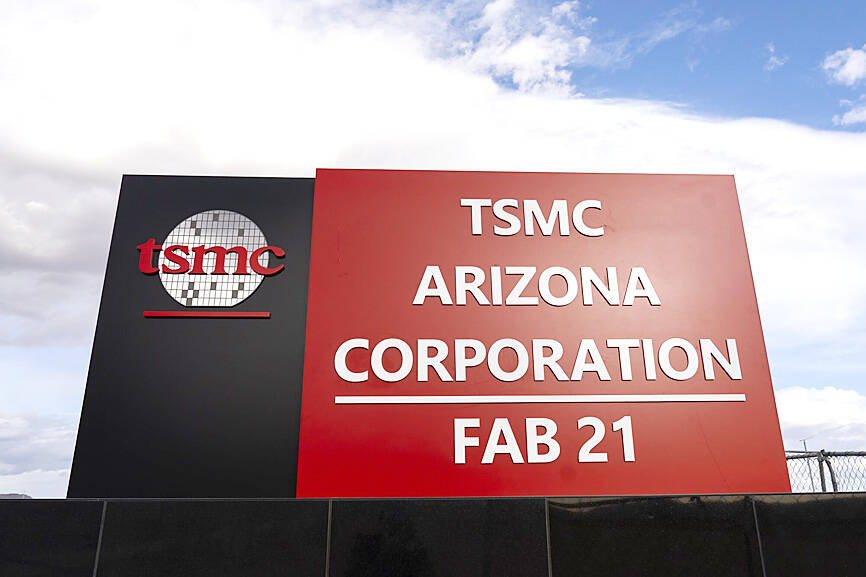
Photo: Bloomberg
That meant local supply would be their preference, given growing macroeconomic uncertainty, he said.
North America has long been the biggest revenue source for TSMC, accounting for 75 percent of the chipmaker’s overall revenue last quarter, with Apple Inc, Nvidia Corp, Advanced Micro Devices Inc, Broadcom Inc and Qualcomm Inc among its major customers.
Zeng’s remarks came after US President Donald Trump and TSMC chairman C.C. Wei (魏哲家) jointly announced at the White House on Monday that the company would invest US$100 billion to build three semiconductor fabs, two advanced packaging plants, and a research and development center.
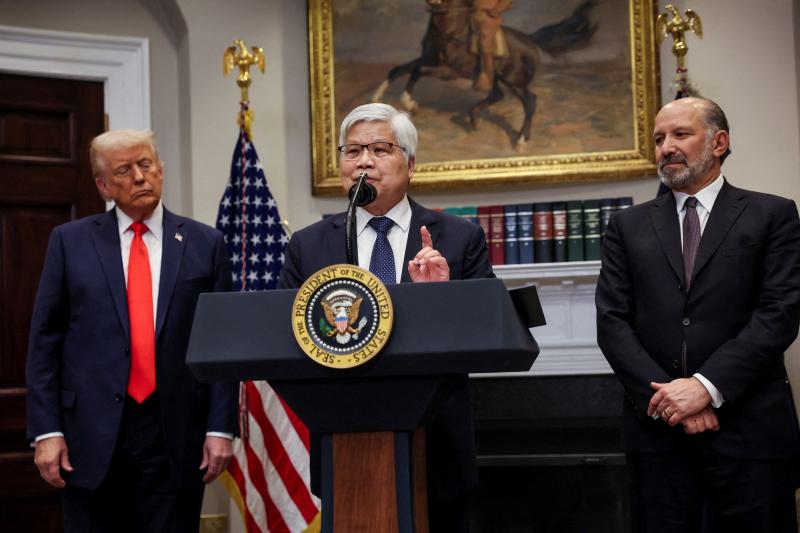
Photo: Leah Millis, Reuters
Together with the company’s previously announced investment of US$65 billion, TSMC would spend a total of US$165 billion in the US, the company said.
TSMC’s investment in Taiwan would remain unchanged, and the company would press ahead with projects in Japan and Germany, it added.
TSMC’s new US investment plan could help alleviate the immediate risk of tariffs on Taiwanese semiconductors, Taishin Securities Investment Advisory Co (台新投顧) analyst Tony Huang (黃文清) said.
However, it is not clear if the company can pass higher production costs on to US clients, Huang said.
On the other hand, Mega International Investment Services Corp (兆豐國際投顧) analyst Alex Huang (黃國偉) said that the US expansion could disrupt the supply-demand balance for TSMC’s Taiwan-based production.
The cost of building facilities in the US could be up to four times higher than in Taiwan, potentially impacting TSMC’s gross margin, he said.
However, Zeng said TSMC should be able to keep its gross margin target at 53 percent until 2028, before ramping up its second fab in Arizona and starting to book new depreciation costs.
Nevertheless, supply-chain firms might follow the step of TSMC.
A TSMC component supplier has said that it is seriously considering building its first production line in the US, as demand would increase significantly.
Wiwynn Corp (緯穎), a supplier of AI servers and components, last week said that it planned to invest US$300 million to build its first manufacturing facility in Texas to cope with the realignment of global supply chains amid escalating macroeconomic uncertainty.
Even so, analysts agreed that expanding in the US is a more viable option than helping rival Intel Corp, following reports that the Trump administration is pressuring TSMC to help boost Intel’s semiconductor manufacturing business.
TSMC’s new US investment plan would help expand its US presence and maintain shareholders’ interest while taming uncertainty linked to geopolitical tensions and punitive tariffs on semiconductors, other analysts said.
“This represents a win-win negotiation,” TF International Securities Group Co (天風國際證券) analyst Kuo Ming-chi (郭明錤) wrote in a post on X.
“The US government clearly knew what it wanted, while TSMC glanced government demands with commercial interests to maximize shareholders’ benefits,” Kuo wrote.
A lack of details provides the flexibility for spending, softening the impact on profitability, he said.
TSMC’s new US investment plan exceeded market expectations, and it was aligned with Trump’s attempt to revitalize manufacturing in the US, Taiwan Institute of Economic Research (TIER, 台經院) research fellow Arisa Liu (劉佩真) said.
However, expanded investment in the US will inevitably affect chip manufacturing in Taiwan, especially in advanced processes, Liu said.
TSMC's expansion plans in Japan may also be affected as resources are spread out, she said.
Liu said that the proportion of chips manufactured in Taiwan may decrease to 75-80 percent as the fabs in Arizona enter the mass production stage.
Looking ahead, Taiwan should focus on delivering cost-effective semiconductors to counterbalance the higher production costs in the US, Liu said, emphasizing that Taiwan will continue to benefit from a well-established ecosystem, a highly efficient supply chain, and a workforce that can operate around the clock — advantages that are difficult to replicate elsewhere.
Nevertheless, it would take a long time for TSMC to fulfill its new investment plans, and the US presidency could change before that, bringing a shift in trade policies that would impact TSMC’s strategy and development, TIER economist Gordon Sun (孫明德) said.
TSMC shares lost 1.96 percent to close at NT$1,000 in Taipei trading yesterday as investors were still digesting the news about TSMC’s new investment plan.
TSMC could issue bonds in the US to finance its new investment, rather than diluting shareholders’ interests through equity offerings, stock analyst Chang Chen-hao (張陳浩) said.
A US bond issuance would provide a hedge against foreign exchange fluctuations, Chang said.
The US investments would prove long-term gains, as it would allow TSMC to save costs in streamlining logistics and material procurement, but it would pose short-term pressure on profit margin, he said.
Additional reporting by CNA
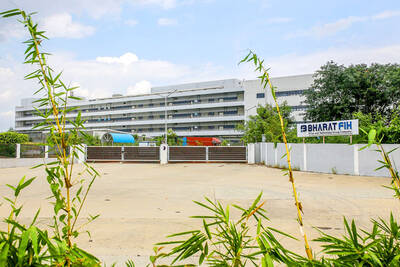
SETBACK: Apple’s India iPhone push has been disrupted after Foxconn recalled hundreds of Chinese engineers, amid Beijing’s attempts to curb tech transfers Apple Inc assembly partner Hon Hai Precision Industry Co (鴻海精密), also known internationally as Foxconn Technology Group (富士康科技集團), has recalled about 300 Chinese engineers from a factory in India, the latest setback for the iPhone maker’s push to rapidly expand in the country. The extraction of Chinese workers from the factory of Yuzhan Technology (India) Private Ltd, a Hon Hai component unit, in southern Tamil Nadu state, is the second such move in a few months. The company has started flying in Taiwanese engineers to replace staff leaving, people familiar with the matter said, asking not to be named, as the
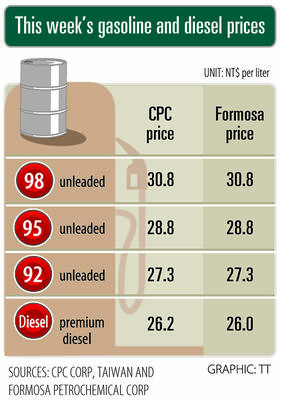
The prices of gasoline and diesel at domestic fuel stations are to rise NT$0.1 and NT$0.4 per liter this week respectively, after international crude oil prices rose last week, CPC Corp, Taiwan (台灣中油) and Formosa Petrochemical Corp (台塑石化) announced yesterday. Effective today, gasoline prices at CPC and Formosa stations are to rise to NT$27.3, NT$28.8 and NT$30.8 per liter for 92, 95 and 98-octane unleaded gasoline respectively, the companies said in separate statements. The price of premium diesel is to rise to NT$26.2 per liter at CPC stations and NT$26 at Formosa pumps, they said. The announcements came after international crude oil prices
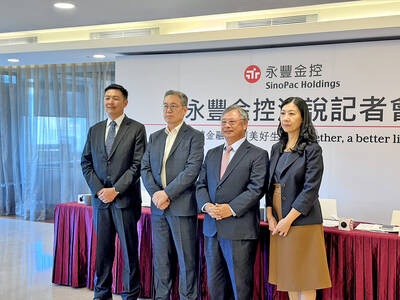
SinoPac Financial Holdings Co (永豐金控) is weighing whether to add a life insurance business to its portfolio, but would tread cautiously after completing three acquisitions in quick succession, president Stanley Chu (朱士廷) said yesterday. “We are carefully considering whether life insurance should play a role in SinoPac’s business map,” Chu told reporters ahead of an earnings conference. “Our priority is to ensure the success of the deals we have already made, even though we are tracking some possible targets.” Local media have reported that Mercuries Life Insurance Co (三商美邦人壽), which is seeking buyers amid financial strains, has invited three financial
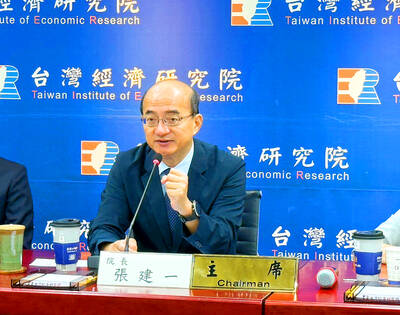
CAUTION: Right now, artificial intelligence runs on faith, not productivity and eventually, the risk of a bubble will emerge,’ TIER economist Gordon Sun said Taiwanese manufacturers turned more optimistic last month, ending a five-month streak of declining sentiment as concerns over US tariffs, currency volatility and China’s overcapacity began to ease, the Taiwan Institute of Economic Research (TIER) said yesterday. The manufacturing business confidence index rose 1.17 points from June to 86.8, its first rebound since February. TIER economist Gordon Sun (孫明德) attributed the uptick to fading trade uncertainties, a steadier New Taiwan dollar and reduced competitive pressure from Chinese producers. Taiwan’s semiconductor industry is unlikely to face significant damage from Washington’s ongoing probe into semiconductors, given the US’ reliance on Taiwanese chips to power artificial